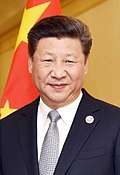Toilet Revolution in China
Toilet Revolution in China (simplified Chinese: 厕所革命; traditional Chinese: 廁所革命; pinyin: Cèsuǒ Gémìng; literally: 'lavatory-place transform-mandate') is a government campaign aimed at improving the sanitary conditions in Mainland China. In 2015, Xi Jinping, General Secretary of the Communist Party of China, announced that China is going to improve the sanitary conditions of public toilets in tourist attractions, about which foreign travelers have long complained. The "Toilet revolution" entry in the State Council Information Office's 2015 "Dictionary of Xi Jinping's new terms" explains the campaign, "Along with agricultural modernization and new rural construction, local governments will ensure that villagers have access to hygienic toilets."[1]
From 2015 to 2017, over 68,000 public toilets were constructed in China. In 2017, construction of an additional 64,000 public toilets was planned.[2][3][4] In the same year, the campaign was geographically expanded, and authorities are going to improve the poor sanitary conditions in rural areas of China. State Media reported that the unsanitary conditions in rural toilets can result in spreading diseases like malaria and the campaign aims at solving such problems.[5]
References
- Victor Mair, Toilet Revolution!!, Language Log 26 November 2017 [n.b., links to numerous references].
- Cheang Ming (2017). "Toilet revolution': China has its sight set on reforming its bathrooms". CNBC.
- Maggie Hiufu Wong (2017). "China to get extreme toilet makeover to boost tourism". CNN.
- Shikun Cheng; et al. (2017). "Toilet revolution in China". Journal of Environmental Management. 216: 347–356. doi:10.1016/j.jenvman.2017.09.043. PMID 28941832.
- 习近平:农村也要来个"厕所革命" [Xi Jinping: Toilet Revolution should also be unfolded in rural area)] (in Chinese). China Daily. 2017.


.svg.png)